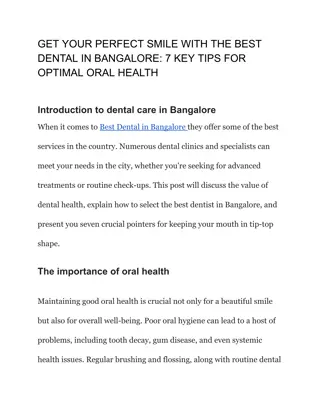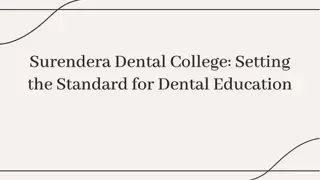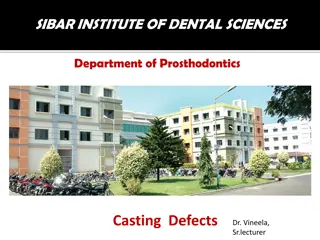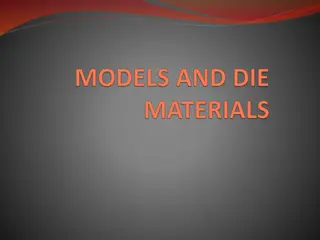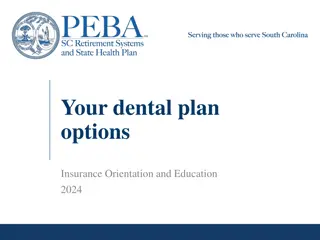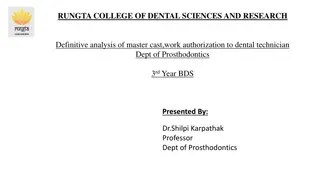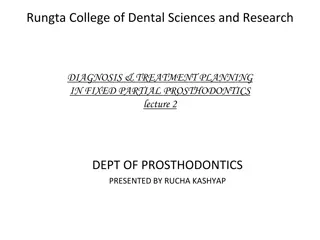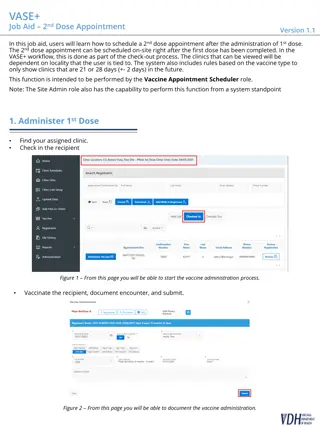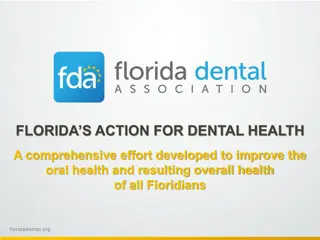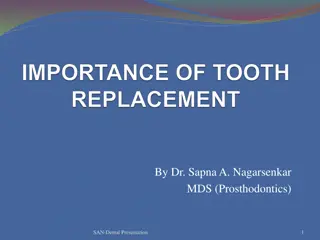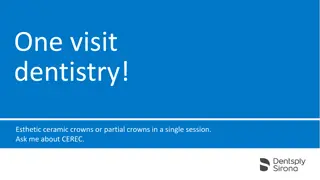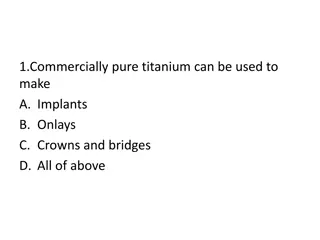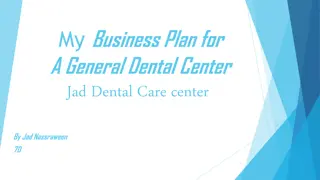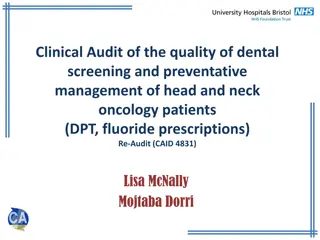Clinical Appointment and Esthetic Try-In in Dental Prosthodontics
Replacement of anterior teeth is crucial for both function and aesthetics. An esthetic try-in appointment allows patients to review and provide feedback on their prosthesis, ensuring both functional and esthetic satisfaction. Additionally, verifying the accuracy of jaw relation records is essential before finalizing treatment.
Uploaded on Sep 18, 2024 | 0 Views
Download Presentation

Please find below an Image/Link to download the presentation.
The content on the website is provided AS IS for your information and personal use only. It may not be sold, licensed, or shared on other websites without obtaining consent from the author. Download presentation by click this link. If you encounter any issues during the download, it is possible that the publisher has removed the file from their server.
E N D
Presentation Transcript
RUNGTA COLLEGE OF DENTAL SCIENCES AND RESEARCH Dept of Prosthodontics 3rd Year BDS Trying of cast partial framework in mouth,adjusting the occlusion. Presented By: Dr.Shilpi Karpathak Professor Dept of Prosthodontics
Specific Learning Objective Core areas Domain Category Introduction Indications for Clinical Appointment Esthetic Try-In Verification of Jaw Relation Materials Cognitive Must Know Clinical procedure Making a polyvinylsiloxane verification record Verifying accuracy of an articulator mounting Cognitive Must Know Psychomotor Must Know Summary Affective Must Know
contents Introduction Indications for Clinical Appointment Esthetic Try-In Verification of Jaw Relation Materials Clinical procedure Making a polyvinylsiloxane verification record Verifying accuracy of an articulator mounting Summary References
Indications for Clinical Appointment The replacement of anterior teeth often represents an important event in the life of an individual. Many cultures place a great deal of emphasis upon physical appearance, and facial esthetics are central to this concept. Although many patients identify improved function as the primary reason for seeking treatment, a sense of vanity always remains. A patient may be dissatisfied with a prosthesis even if it meets all functional and biologic requirements. Therefore, if anterior teeth are to be replaced, an esthetic try-in is essential. A try-in appointment allows the patient to view the prosthesis and provide feedback. This appointment also allows the practitioner to evaluate the esthetic and phonetic characteristics of the prosthesis and to make appropriate changes in the arrangement of teeth
An additional indication for the appointment is to verify the accuracy of jaw relation records made during the previous appointment. If there is any doubt regarding the accuracy of the articulator mounting, a try-in appointment should be scheduled.
Esthetic Try-In The patient should be seated in a treatment room that provides a quiet, relaxed atmosphere. This helps to alleviate the tension that may develop as the patient views the tooth arrangement for the first time. The denture base need not be waxed to full contour, but it should be neat, clean, and resistant to tooth displacement. The practitioner should carefully insert the removable partial denture and tell the patient to avoid the application of biting forces. The patient may then be directed to close lightly to ensure that no interferences are present
The patient should be encouraged to relax. When the patient is at ease, the teeth may be evaluated. It is better if the dentist examines the teeth before the patient has an opportunity to observe them. This gives the practitioner an opportunity to correct noticeable discrepancies without upsetting the patient. The dentist should evaluate the positions of anterior teeth and assess lip support. There is a tendency to position the artificial teeth lingual to the positions occupied by the natural teeth
Tooth length should be carefully evaluated. If all anterior teeth are being replaced and the upper lip is of normal length, the edges of the central incisors should be visible when the lip is relaxed. When the lip is drawn upward (eg, in an exaggerated smile), the gingival contours of the denture base should be minimally evident If an anterior edentulous space has been decreased by drifting of the teeth, a decreased number of teeth should not be placed. This technique usually results in an abnormal appearance. Instead, attempts should be made to rotate or overlap the denture teeth in order to achieve an acceptable esthetic result
If the anterior edentulous space is relatively large, diastemata may be incorporated into the tooth arrangement. If this is to be accomplished, the patient should be informed of potential difficulties associated with interdental spacing. Spacing complicates oral hygiene procedures, increases the likelihood of food impaction, and may create difficulties with phonetics. Attention should be paid to the horizontal and vertical overlap of the anterior teeth. If some natural anterior teeth remain, the overlap should be duplicated. If no natural teeth remain, care should be taken to avoid excess sive vertical overlap without accompanying horizontal overlap. This could result in the application of undesirable forces to the artificial teeth and associated soft tissues
Vertical alignment of the teeth also should be evaluated. A slight deviation from the vertical can produce an acceptable esthetic result, but a significant deviation can create esthetic difficulties. The practitioner should pay particular attention to the maxillary midline. This midline must be examined for its vertical alignment and for its midface position. Any error in the position of the maxillary midline can be extremely distraction
Verification of tooth shade should be accomplished during the evaluation process. The presence of natural teeth makes shade selection and patient acceptance a critical component of removable partial denture therapy. To ensure selection of an appropriate shade, the prosthesis should be viewed using a variety of light sources (eg, natural, fluorescent, and incandescent)
Once the technical and mechanical requirements are satisfied, the patient should be allowed to view the tooth arrangement and comment on the results. The patient should stand several feet from a wall mirror to examine the teeth critically. The use of a hand mirror should be discouraged because the patient s attention will be focused on individual teeth and not on the overall effect of the prosthesis. The patient s remarks should be noted, and required changes should be made. Arrival at mutual acceptance by the patient and dentist frequently demands a high level of communicative skill combined with psychological insight.
Treatment should not proceed until patient approval has been gained. Many practitioners insist upon written approval by the patient. When uncertainty exists, a suitable entry should be placed in the record and signed by the patient
Verification of Jaw Relation The jaw relation only needs to be verified in limited instances: 1. If problems were encountered during jaw relation procedures and there is any doubt regarding the accuracy of the articulator mounting 2. If the partial denture is opposed by a complete denture 3. If all posterior teeth in both arches are being replaced 4. If there are no opposing natural teeth in contact and verification of the occlusal vertical dimension is necessary.
Clinical procedure The patient should be seated, and the partial denture tried in the mouth. Visual observation of occlusal contacts should be used to determine whether gross errors are present. Necessary adjustments should be made. The patient should be permitted to wear the prosthesis for 3 to 5 minutes. During this time, the patient should be encouraged to speak. The practitioner should engage in conversation with the patient, using this opportunity to assess the phonetic and esthetic qualities of the prosthesis.
Normally, if two prostheses are being constructed, the recording medium is placed on the mandibular teeth for convenience. However, if the mandibular prosthesis does not provide a suitable platform, the recording medium may be placed on the maxillary prosthesis
Making a polyvinylsiloxane verification record The practitioner should rehearse the record making procedure with the patient before placing the recording medium in the oral cavity. When this has been accomplished, the practitioner should begin the record- making process. The patient is instructed to open the mouth moderately. The fingers of one hand are positioned to permit visualization of the dental arches . The polyvinylsiloxane registration material is mixed and introduced into the patient s mouth . The operator s remaining hand is then positioned on the facial surfaces of the mandibular anterior teeth, and the patient is guided into the prescribed closure. This position is maintained until the polyvinylsiloxane material has reached a suitable consistency
When the recording medium has set, the patient is instructed to open the mouth. The record and removable partial denture (or dentures) are removed from the oral cavity. The record is carefully examined to determine its acceptability. There should be no signs of penetration through the record. If the record is acceptable, it is properly trimmed using a surgical scalpel. Additional records may be made in a similar manner
Verifying accuracy of an articulator mountin There are a number of methods for determining the accuracy of an articulator mounting. The most commonly used methods include (1) assessment of cast-to- record adaptation when the articulator is closed in a terminal hinge position and (2) examination of the relationships between the condylar elements and condylar housings when the mounted casts are properly seated in a jaw relation record. The objective of the two techniques is the same to determine the repeatability of closure. The major difference is the way in which the results are checked
When using the first method, the articulator is placed in its terminal position (ie, the position at which the condylar elements are completely seated in their housings). In many instruments, the condylar elements may be locked into this terminal position using some form of governing device. A jaw relation record is placed on one cast, and the articulator is gently closed. During closure, the practitioner observes the relationships between the occlusal surfaces and the jaw relation record. The occlusal surfaces should follow an arcuate pathway into the record and should display excellent adaptation to the record . The practitioner should never apply pressure to the articulator or casts because this will distort the record and provide an inaccurate result.
When using the second method, the condylar elements are unlocked and permitted to move freely within their condylar housings. A jaw relation record is placed on one cast, and the remaining cast is gently settled into this record. If the casts cannot be accurately positioned in the record, an inaccuracy exists, and the practitioner must determine the source of this inaccuracy. If the casts can be accurately positioned in the record, the practitioner must assess the relationship between the condylar elements and the condylar housings. Each condylar element should be located in its terminal position. As previously noted, the practitioner should not apply undue pressure to the articulator or casts when evaluating the mounting
f the original mounting is verified as correct, the practitioner may proceed. If the accuracy of the original mounting cannot be verified, another jaw relation record should be made and the mounting should be reevaluated. If this record fails to verify the original mounting, the practitioner should suspect an inaccuracy in the mounting and should remount the mandibular cast. The verification process should then be repeated. Completion of the prosthesis should not be considered until the practitioner has verified the accuracy of the mounting
Summary Depending on the difficulty encountered, the experienced practitioner should be able to complete the clinical procedures in 30 to 60 minutes. A dental student usually will require 1 to 2 hours
References Stewert s Clinical Removable Partial Prosthodontics, 4th Edition Textbook of Prosthodontics, V.Rangarajan 2nd Edition







